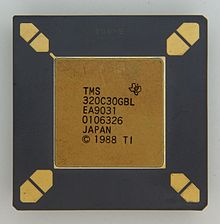Simple Instruction Set Computing
- Simple Instruction Set Computing
-

El procesador digital de señales TMS320 utiliza la arquitectura SISC.
SISC (Simple Instruction Set Computing) es un tipo de arquitectura de microprocesadores orientada al procesamiento de tareas en paralelo. Esto se implementa mediante el uso de la tecnología VLSI, que permite a múltiples dispositivos de bajo costo que se utilicen conjuntamente para resolver un problema particular dividido en partes disjuntas. La arquitectura RISC es un subconjunto del SISC, centrada en la velocidad de procesamiento debido a un conjunto de instrucciones reducido.[1]
Microprocesadores SISC (o RISC) nunca han logrado amenazar el amplio dominio de los procesadores CISC en los ordenadores personales, debido a su popularidad y al aumento constante en la capacidad de procesamiento de los mismos.[2] Por lo tanto, el uso de RISC y SISC sigue limitado a necesidades muy específicas de procesamiento, como en los procesadores DSP.[3]
Referencias
Enlaces externos
Wikimedia foundation.
2010.
Mira otros diccionarios:
Complex instruction set computing — A complex instruction set computer (CISC) ( /ˈsɪs … Wikipedia
Instruction set — An instruction set, or instruction set architecture (ISA), is the part of the computer architecture related to programming, including the native data types, instructions, registers, addressing modes, memory architecture, interrupt and exception… … Wikipedia
Reduced instruction set computer — The acronym RISC (pronounced risk ), for reduced instruction set computing, represents a CPU design strategy emphasizing the insight that simplified instructions which do less may still provide for higher performance if this simplicity can be… … Wikipedia
One instruction set computer — Computer science portal A one instruction set computer (OISC), sometimes called an ultimate reduced instruction set computer (URISC), is an abstract machine that uses only one instruction – obviating the need for a machine language opcode … Wikipedia
Computing — For the formal concept of computation, see computation. For the magazine, see Computing (magazine). For the scientific journal, see Computing (journal). A difference engine: computing the solution to a polynomial function … Wikipedia
History of computing hardware — Computing hardware is a platform for information processing (block diagram) The history of computing hardware is the record of the ongoing effort to make computer hardware faster, cheaper, and capable of storing more data. Computing hardware… … Wikipedia
Instruction pipeline — Pipelining redirects here. For HTTP pipelining, see HTTP pipelining. Basic five stage pipeline in a RISC machine (IF = Instruction Fetch, ID = Instruction Decode, EX = Execute, MEM = Memory access, WB = Register write back). In the fourth clock… … Wikipedia
List of computing and IT abbreviations — This is a list of computing and IT acronyms and abbreviations. Contents: 0–9 A B C D E F G H I J K L M N O P Q R S T U V W X Y … Wikipedia
Pointer (computing) — This article is about the programming data type. For the input interface (for example a computer mouse), see Pointing device. Pointer a pointing to the memory address associated with variable b. Note that in this particular diagram, the computing … Wikipedia
Timeline of computing 1950–1979 — History of computing Hardware before 1960 Hardware 1960s to present Hardware in Soviet Bloc countries Artificial intelligence Computer science Operating systems Programming languages … Wikipedia

